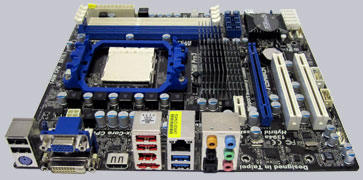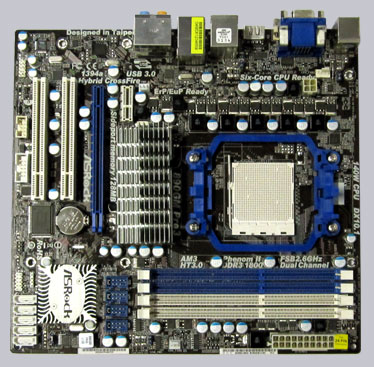
Result and general impression
++++ The ASRock 890GM Pro3/M/ASR motherboard has a price of approx. 90 Euro (07/2010) and is thus in the middle price segment of the Socket AM3 motherboards.
A few weeks ago, the ASRock 890GX Extreme3 motherboard was tested at ocinside.de and the result was excellent with the updated BIOS version. In this review, an equivalent Micro ATX board with 890GX chipset is overclocked to the limit. This mATX motherboard has also integrated USB3.0, SATA3 and eSATA3, as well as the fast onBoard HD4290 GPU with sideport memory. Let us see, if this small 890GM Pro3 mATX motherboard can keep up with the large 890GX Extreme3 ATX board.
On the box one can already see some features like USB3.0, SATA3, eSATA3 and UCC:
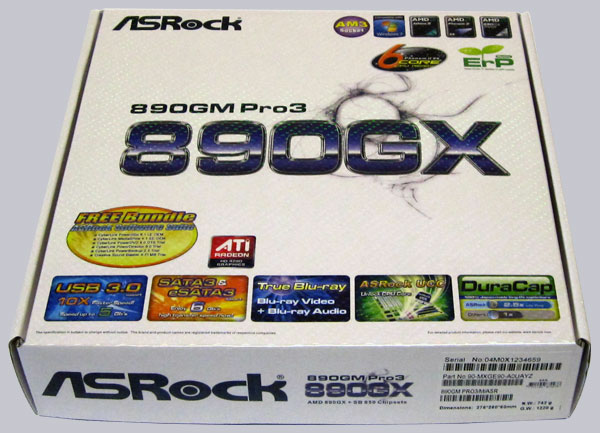
A first look to the black 890GM Pro3 shows a high-quality motherboard with high-quality solid caps capacitors and a blue/white motherboard design:
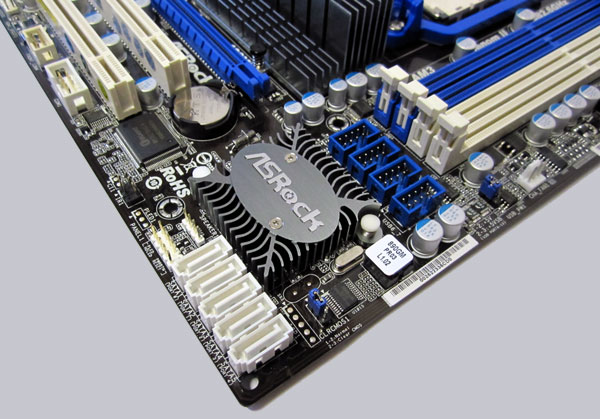
Equipment and other features …
ASRock’s 890GM Pro3 motherboard comes with a manual, quick reference guides, one DVD, four SATA data cables and one ATX I/O shield.
Expansion cards …
This motherboard offers one PCI Express 2.0 video card slot with x16 band-width. Additionally to the PCI Express 2.0 slot there are 2 PCI slots and one x1 PCIe 2.0 slot. That’s not very much, but it’s OK for a micro ATX motherboard.
Memory …
The ASRock 890GM Pro3 can be equipped with up to four DDR3 modules and is expandable depending upon operating system used (see list) to maximally 16 GB memory.
The Socket AM3 motherboard supports DDR3 memory modules and can be optimized in the BIOS for DDR3-800, DDR3-1066, DDR3-1333 or DDR3-1600 and faster Dual Channel modules. DDR3-1800 or higher clock-rates are currently only possible with overclocking, but for this reason you can visit ocinside.de … 😉
Hard disk drive connectors …
The 890GM Pro3 offers, as well as the equivalent ATX 890GX Extreme3 board, no floppy connector and no IDE connectors for conventional ATA 133 drives. But this 890 GM Pro 3 board offers five SATA 3 connectors (6 Gb/s) and one eSATA3 port in the I/O panel. The S-ATA3 ports supports RAID 0, RAID 1, JBOD, RAID 0+1, RAID5, NCQ, AHCI and the Hot Plug function in AHCI mode (AHCI stands for Advanced Host Controller Interface).
The manual and the included DVD contains all basic information to manage a new installation of Windows XP, Windows Vista or Windows 7 with S-ATA3 hard disk drives, and how to make a RAID installation. 32-Bit and 64-Bit drivers for Windows XP, Windows Vista and Win7 are provided on the DVD and can be downloaded on the ASRock support page.
USB and Firewire …
The board has one USB 3.0 connectors on the ATX-panel which is offered by the Fresco FL 1000G controller IC. Furthermore, it offers five USB 2.0 connectors on the ATX panel, four internal USB 2.0 plugs for up to eight optional USB2 ports. So ASrock utilize the latest USB3.0 technology with up to 5 Gb/s and all USB 2.0 ports of the chipset. Additionally, the board has one IEEE1394 Firewire port on the I/O panel and another optional internal IEEE1394 port.
Network …
The Realtek RTL 8111E chip is integrated on the ASRock 890GM Pro3 motherboard and offers a WoL capable 10/100/1000 network connector in the ATX panel.
Serial and parallel port …
This motherboard does not provide a parallel port and the serial port is only optionally available as internal connector.
Sound …
The ASRock 890GM Pro3 motherboard is equipped with the VIA VT2020 HD audio codec with content protection, which supports 7.1 surround sound for example analog over 5x 3.5mm connectors on the ATX panel or over the internal HD_Audio connector.
For the digital output there is no internal HDMI SPDIF out connector available, but there is an optical digital SPDIF output on the ATX panel and premium Blu-Ray audio support. So most users don’t need to buy an additional sound card with digital outputs and building an HTPC should be no problem at all regarding the sound.
Graphics …
The new ATI Radeon HD4290 IGP of the AMD 890GX chipset is also without overclocking faster than the previous IGPs and support in addition DX10.1. The benchmark result of the HD4290 GPU (AMD 890GX) is with 3DMark06 2195 points a little bit slower than the HD4290 GPU of the 890GX Extreme3 with 3DMark06 2249 points, a little bit faster than the HD3300 GPU (AMD 790GX) with 3DMark06 2235 points (700 MHz GPU on a M3A790GXH/128M) and the HD4200 (AMD 785G) with 3DMark06 1571 points (500 MHz GPU clock on a M3A785GXH/128M). With Hybrid CrossFireX technology in combination with an additional ATI video card, the benchmark result would be higher on all IGPs. However, only few video cards are applicable (e.g. a ATI Radeon HD3450) officially to cooperate with the integrated video chip as Hybrid CF. AMD and ASRock made a good job with their onboard graphics solution and achieve higher performance on the same frequeny with lower power consumption nearly every half year.
Furthermore the HD 4290 video processor supports DirectX 10.1, has integrated 128MB Sideport RAM on the 890GM Pro3 motherboard, supports HDCP, Full HD 1080p and offers thanks to its onBoard HDMI connector optimal conditions for a Home theatre PC.
Here is a picture of the ATX panel connectors:
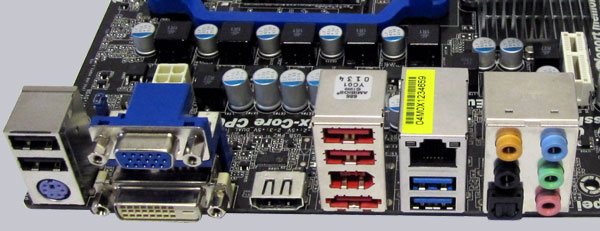
From left to right one can see 2x USB 2.0 ports, the PS/2 connector for a PS/2 keyboard, 15-pol Sub-D VGA, DVI-D VGA, HDMI, 2x USB 2.0 and IEEE1394 and eSATA3, RJ45 Gigabit LAN and 1x USB 2.0 port and 1x USB 3.0 port, optical SPDIF out and 5x 3.5mm jacks for analog sound.
BIOS and Overclocking …
Let us continue with BIOS options and BIOS overclocking. By pressing F2 or Del, you get access to the AMI BIOS with all important hardware settings.
The P1.60 BIOS offers a lot of DDR3 memory settings like e.g. the memory frequency setting from 400 MHz over 533 MHz and 667 MHz on up to 800 MHz (DDR3 800/1066/1333/1600). The frequency of all memory modules is calculated and shown immediately after changing the reference clock and makes it much easier to adjust the right RAM frequency.
The host clock is adjustable from 150 MHz up to 500 MHz and the HT (hypertransport) frequency is adjustable from 1x to 10x (200 to 2000 MHz). The PCIe frequency is adjustable from 75 MHz up to 250 MHz and with the asynchronous or synchronous setting of the CPU/PCIe bus, it is possible to increase the host frequence independent of the PCI and PCIe clock. Changes to the CPU frequency is directly shown in the BIOS, so if you change for example the reference clock, you will see how high the CPU frequency would be with each divisor on this setting.
With asynchronous clock setting, it was possible to reach a enormous high 320 MHz reference clock and even with onboard GPU it was possible to overclock the reference clock up to 320 MHz. Some may think that the reference clock is no longer important for overclocking of e.g. Black Edition processors with free multiplier selection, but the reference clock is still important for good PC overclocking results. At least when one buy high-end OC RAM and like to operate it on the maximum frequency, because this is on most boards only possible with reference clock increasement. And of course not every user like to spend more money for these AMD BE CPUs.
The boot failure guard was checked in this review as well and it was possible to start the PC on standard values with too high overclocking settings without using the Clear CMOS Jumper. It was just necessary to press the RESET button.
Another interesting feature is the so-called UCC BIOS setting. With the Unlock CPU Core feature it was possible to unlock deactivated CPU Cores. Unfortunately it’s not possible with every AMD Athlon II or Phenom II CPU, but the BIOS options are nevertheless present and this is surely for some buyers an important purchase aspect. The UCC option was called Advanced Clock Calibration or short ACC on previous motherboards and can be unlocked on the ASRock board with this additional UCC IC.
Instead of ACC this 890GM Pro3 with additional UCC chip to unlock CPU Cores of some processors:
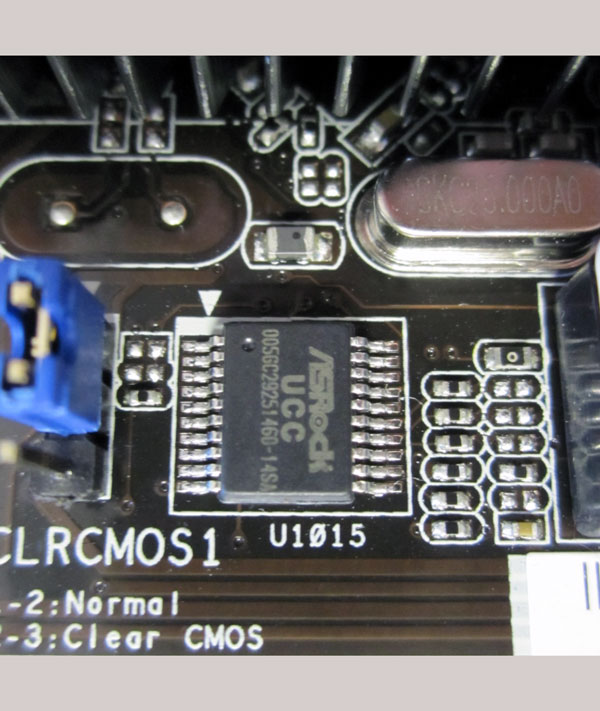
Furthermore, this board offers a NB voltage from 0.6000 Volt to 1.7500 Volt, a Vcore setting on the Phenom II test CPU from 0.6000 Volt to 1.7500 Volt, a HT voltage setting from 1.20 to 1.30 Volt and a few more settings to overclock the platform more stable. The DDR3 memory voltage can be set between 1.30 Volt up to 2.05 Volt in steps of 0.05V. The GPU can be adjusted from 350 MHz to 2000 MHz and the Sideport memory can be clocked from 533 MHz to 1700 MHz.
Who don’t know all of these settings or who don’t like to know more about overclocking, can try to use the turbo 30 menu.
In the turbo 30 menu one can increase the system performance automatically to 30% if the components support it with the necessary luck. Just select the System Performance Increases 30% setting in the OC Tweaker Turbo30 menu and some components of the system will be overclocked by 30 percent. The 2600 MHz CPU is now overclocked to approx. 3120 MHz and also the GPU is overclocked with this setting. As special BIOS feature one can store different BIOS settings also with a desired name or share it with other users by ASRock OC DNA. Thus one can save for example balanced BIOS settings, overclocking settings and underclocking settings in a user profile of the BIOS to load them very quickly at any time.
The downclocking or underclocking was also tested in this review. It was possible to lower the AMD Phenom II 710 CPU multiplier over the BIOS to 0.5x and th processor can be underclocked in such a way with 150 MHz reference clock to approx. 75 MHz. Even if probably nobody like to underclock an AMD Phenom II 710 processor from 3x 2600 MHz to 3x 75 MHz CPU clock. With unlocked fourth core of the AMD Phenom II 710 CPU it was possible to underclock down to 100MHz.
Underclocking and OverClocking is outside of the manufacturers specification, so it’s necessary to have a bit luck and ASRock give several options to overclock or underclock the system.
Several energy saving options are available on this ASRock motherboard, because the ASRock 890GM Pro3 board offers the Away Mode, which is particularly very important when using Microsoft Windows MCE (Media Center Edition) to e.g. record TV shows when the PC system is nearly powered off. Who like to boot much faster, should try the ASRock Instant Boot function. And IES (Intelligent Energy Saver) reduces the power consumption by lowering voltages on less load. The features can be e.g. adjusted with the included OC Tuner Software and in our test it was also possible to overclock with activated CnQ feature. The current consumption of the test PC with AMD Phenom II 710 X3 CPU, 4GB DDR3-1333 memory, onBoard HD 4290 graphics, hard disk drive and Cooler Master Silent Pro M 600 W test PSU was without overclocking depending upon load between approx. 82 Watt and 113 Watt. With Gigabyte GTS250 card the power consumption was between 115W and 207 Watt and with a Sapphire HD4870 video card it was between 148W and 227 Watt Compared to this value, the current consumption with Sapphire HD4870 video card and an older, smaller Enermax test power supply was between 89W and 145W.
The BIOS of the passive cooled 890GM Pro3 motherboard supports by the way a CPU Quiet Fan option (temperature fan control) for 4-pin CPU fans.
ASRock offers addionally a very comfortable option to flash a BIOS update. By the so-called ASRock Instant Flash option (Advanced BIOS) or during the PC start one can get into the ASRock Instant Flash utility. Hereby one can very easy upgrade a downloaded ASRock BIOS without further boot CD, boot stick, boot disk, etc. Just start the ASRock Instant Flash utility. Then select a BIOS Flash ROM from any FAT formatted device like an USB Stick to flash the BIOS without without another boot medium.
Result …
The ASRock 890GM Pro3 AMD Socket AM3 motherboard for DDR3 memory modules offers thanks to the AMD 890GX chipset very high overclocking results, offers also without additional graphics card a high performance and has integrated a lot of modern features at a good price.
The basic equipment is great and offers five SATA3 ports with RAID support, one eSATA3 connector, one USB 3.0 port, up to thirten possible USB 2.0 ports, two possible IEEE1394 ports, Gigabit LAN, 7.1 sound, analog sound output over five connectors, digital sound output over one optical SPDIF connector and video output over D-Sub, DVI-D or HDMI.
Floppy disk connector, conventional IDE connectors, parallel port and a few other older standards are not anymore available. But of course there are a lot of ways to get these interfaces with inexpensive PCI I/O cards, PCIe I/O cards, SATA to IDE adapter, USB to LPT adapters or similar hardware.
All in all this mATX board is thus for example perfectly suitable for a HTPC and supplies in spite of the small micro ATX size a lot of features to build an excellent Socket AM3 PC system. And if there is place for a ATX mainboard inside of the PC case, one can decide to buy the ASRock 890GX Extreme3 ATX motherboard for about 10 euros more, to get more additional features.
Here you can buy the ASRock 890GM Pro3 motherboard. *Ad
Special thanks to ASRock for their support.
* All Socket AM2 / AM3 PCIe motherboard reviews since 01.07.2010 are based on an AMD Phenom II 710 X3 CPU, 1x Gigabyte GV-N250OC-1GI Nvidia GTS250 PCI Express 2.0 video card, 2x Sapphire HD4870 512MB ATI Radeon HD4870 PCI Express 2.0 video cards, 2x 1024MB Crucial Ballistix Tracer DDR2-1066/PC2-8500 memory modules on DDR2 mainboards or 2x 2048MB Crucial Ballistix Tracer DDR3-1333/PC3-10600 memory modules on DDR3 mainboards, Cooler Master Silent Pro M 600W power supply unit and the following software configuration: Microsoft Windows 7 RC, Microsoft Windows Vista Ultimate, Windows XP SP2, SiSoftware Sandra 2010c, Futuremark 3DMark03, 3DMark06 and 3DMark Vantage (the software is available in the Links & Downloads section). All benchmark results only offer a comparison among themselves for a rough motherboard performance comparison.
Back to the AMD Athlon 64 and AMD Phenom motherboard comparison !


